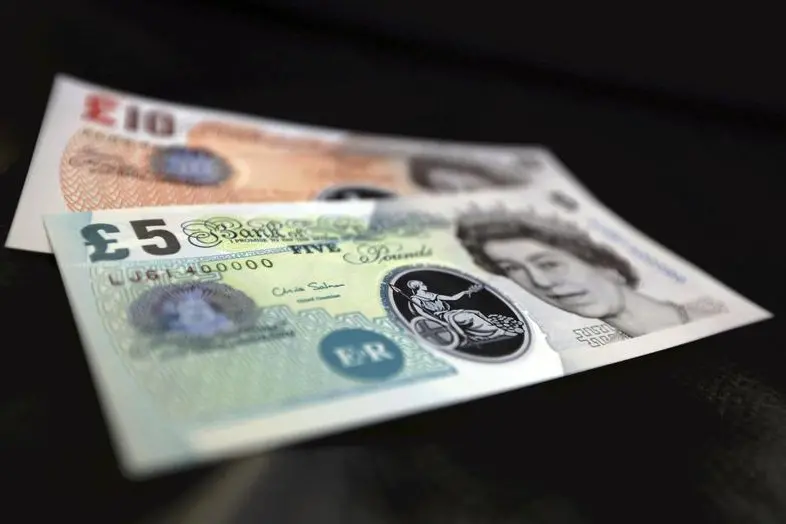PHOTO
(Recasts, updates prices)
LONDON, July 1 (Reuters) - Sterling fell to a three-year low against a basket of currencies on Friday, dragged down by expectations that the Bank of England is likely to ease policy in coming months to cushion the economy from the impact of Britain's vote to leave the European Union.
British government bond yields
GB10YT=RR
On Thursday, Governor Mark Carney, who had previously warned of a possible recession in Britain if it chose to leave the EU, hinted at more stimulus.
The BOE's Monetary Policy Committee will announce an initial assessment of the situation on July 14, after its next scheduled meeting, Carney added. Money markets, based on sterling overnight indexed swaps, were pricing in a rate cut in August or September, although some economists said the BoE could ease policy in July itself.
The euro rose to 83.95 pence, up 0.6 percent on the day, its highest since March 2014. If it rises past 84 pence, it will be the single currency's highest since December 2013.
Against the dollar, sterling was 0.3 percent lower at $1.3277
"Governor Carney standing ready to cut interest rates in the summer as the British economy undergoes post-traumatic stress has pushed front-end gilts into negative-yielding territory," said Hans Redeker, head of currency strategy at Morgan Stanley. He added this suggested a weaker currency and lower real rates of interest.
The pound fell almost 8 percent last Friday, the steepest daily decline in the post-1973 floating-exchange-rate era, after the result of Britain's EU referendum stunned markets. Those losses continued into Monday, with sterling shedding another 3 percent and markets firmly in risk-off mode.
As risk appetite and stock markets recovered this week, so did sterling, gaining more than 1.5 percent on Tuesday and Wednesday against the dollar.
But most of those gains were wiped away on Thursday as investors bet that interest rates would be cut further from their current record lows in the months to come.
The currency showed little reaction to a better-than-expected reading of manufacturing sector activity for June. The Markit/CIPS UK Manufacturing PMI rose to 52.1 in June from 50.4 in May, its strongest reading since January and better than consensus forecast for a reading of 49.9.
"Investors essentially ignored the data as most of the responses were collected before last week's referendum," said a spot trader in an American bank. "It's the July data that will be watched much more closely when that starts to roll in."
Most of the world's biggest banks are forecasting a fall in sterling to $1.20. Forecasts for sterling by the end of the year have been cut by up to 30 cents since Friday.
(Reporting by Anirban Nag; Editing by Jon Boyle and Dominic Evans) ((anirban.nag@thomsonreuters.com)(+44 020 7542 8399)(Reuters Messaging: anirban.nag.thomsonreuters@reuters.net))
LONDON, July 1 (Reuters) - Sterling fell to a three-year low against a basket of currencies on Friday, dragged down by expectations that the Bank of England is likely to ease policy in coming months to cushion the economy from the impact of Britain's vote to leave the European Union.
British government bond yields
On Thursday, Governor Mark Carney, who had previously warned of a possible recession in Britain if it chose to leave the EU, hinted at more stimulus.
The BOE's Monetary Policy Committee will announce an initial assessment of the situation on July 14, after its next scheduled meeting, Carney added. Money markets, based on sterling overnight indexed swaps, were pricing in a rate cut in August or September, although some economists said the BoE could ease policy in July itself.
The euro rose to 83.95 pence, up 0.6 percent on the day, its highest since March 2014. If it rises past 84 pence, it will be the single currency's highest since December 2013.
Against the dollar, sterling was 0.3 percent lower at $1.3277
"Governor Carney standing ready to cut interest rates in the summer as the British economy undergoes post-traumatic stress has pushed front-end gilts into negative-yielding territory," said Hans Redeker, head of currency strategy at Morgan Stanley. He added this suggested a weaker currency and lower real rates of interest.
The pound fell almost 8 percent last Friday, the steepest daily decline in the post-1973 floating-exchange-rate era, after the result of Britain's EU referendum stunned markets. Those losses continued into Monday, with sterling shedding another 3 percent and markets firmly in risk-off mode.
As risk appetite and stock markets recovered this week, so did sterling, gaining more than 1.5 percent on Tuesday and Wednesday against the dollar.
But most of those gains were wiped away on Thursday as investors bet that interest rates would be cut further from their current record lows in the months to come.
The currency showed little reaction to a better-than-expected reading of manufacturing sector activity for June. The Markit/CIPS UK Manufacturing PMI rose to 52.1 in June from 50.4 in May, its strongest reading since January and better than consensus forecast for a reading of 49.9.
"Investors essentially ignored the data as most of the responses were collected before last week's referendum," said a spot trader in an American bank. "It's the July data that will be watched much more closely when that starts to roll in."
Most of the world's biggest banks are forecasting a fall in sterling to $1.20. Forecasts for sterling by the end of the year have been cut by up to 30 cents since Friday.
(Reporting by Anirban Nag; Editing by Jon Boyle and Dominic Evans) ((anirban.nag@thomsonreuters.com)(+44 020 7542 8399)(Reuters Messaging: anirban.nag.thomsonreuters@reuters.net))












